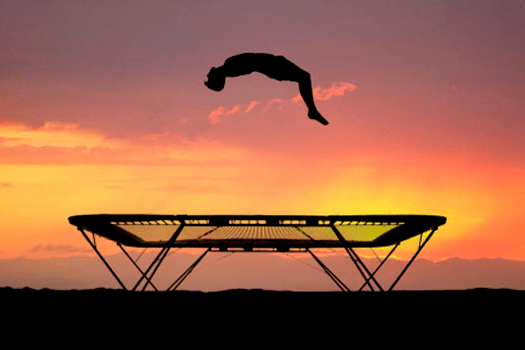Sunday Health Hack No. 26 – Get a Rebounder (a small trampoline), put it in your (home) office, and have some fun in your work-breaks – to the benefit of your bodily and mental health.
Stick with me! When I stumbled across this, I had a sneer on my face too. That’s something we did when we were “little kids”, I first thought. But the smirk quickly vanished when I became aware that the study which I was reading was conducted by NASA, with the conclusion that “rebounding” has since the 80ies become an important part of their astronaut’s physical training regimen.
So there must be something to it.
As you can imagine, there are distinctive challenges associated with the loss of gravity, and these obstacles can affect astronauts even when they return back to earth. To combat health risks associated with space travel, NASA scientists heavily research effective ways of preparing and maintaining the bodies of their space crew.
This NASA academic paper “Body Acceleration Distribution and O2 Uptake in Humans During Running and Jumping” is not the easiest read, but it contains a wealth of information about the benefits of rebounding on a trampoline. It goes into detail about oxygen consumption and muscular involvement, and eventually concludes that bouncing provides better all-around benefits than running, isotonic (weight lifting) and isometric exercise.
The researchers concluded that “rebound exercise is the most efficient, effective form of exercise yet devised” and that 10 minutes of “bouncing” is a better cardiovascular workout than 30 minutes of running (and also burns much more calories).
Since then, trampoline exercise has been used by NASA astronauts to build bone density and muscle mass, improve balance, coordination, motor skills and cardio fitness. And it’s beneficial for the lymphatic system too (your detoxification system, helping your body to flush out toxins, bacteria, dead cells, and other waste products).
And aside from a better burn, rebounding is also a lower impact, high-intensity workout. The trampoline absorbs the shock so there’s less pressure on your joints, reducing your risk of soreness and injury.
So, not only for super-fit austronauts, but rebounding is also a perfect exercise for obese people to start exercising.
And as the body ages, the curvature on the spine increases. Rebounding has been shown to help maintain proper body alignment and a strong posture.
Extra tip for women: Cellulite is most often caused by a stagnant lymph system. By increasing the lymphatic flow in your body, rebounding can eradicate one of the main factors that lead to non-hereditary cellulite. And because of the increased blood flow and the involvement of every cell in your body when rebounding, already existing cellulite skin can get firm again.
Extra office tip: Rebounding improves the then oxygen-loaded blood circulation to the brain, which aids in proper brain function, focus and memory. Additionally rebounding helps to elevate your mood with the rush of feel-good hormones you get from this “fun, childish” exercising.
But rebounding also reduces common office desk related pains such as neck pains, back pains, and headaches.
So for many, many (health) reasons, my Sunday Health Hack for today is – Get a small rebounder, put it in your office or on your terrace (or wherever your space is you regularly visit or reside), but not in your cellar.
Small rebounders are inexpensive too, something around 50 Euro. And always get one with a handle for balance / safety reasons.
This is the one I use (no affiliation) – https://amzn.to/39QpU7k
And don’t make it too complicated. Just “bounce” for a couple of minutes, but many times a day.
Studies show that one can focus on an (office) issue for around 45-60min. So take regular short breaks during the day, and maybe while your coffee/tea is brewing, you rebound for 3-4min, before returning fully rejuvenated, focused and in a good mood to your desk again.
Another good time for rebounding is right in the morning. Studies have shown that, when rebounding a couple of minutes in the morning, you will much more likely make many & much healthier choices throughout the day.
And my final extra tip: After your morning or short break rebounding session, hang on to your pull-up bar for “recovery” (while getting your breath back), see my last Sunday Health Hack “Spine up & hang in there”, for stacking several health benefits without any effort.
And just in case you are still smirking – give it a try. In the first minute you are tempted to explore the “kid-fun” side by diving full in, bouncing up and down as high as you can. Towards the end of the first minute, suddenly your calf muscles start to burn and you think “Okay, maybe I should slow down a little bit”. After two minutes your breathing becomes heavier and sweat appears on your forehead, and you think “Damn, that felt much easier when I was a child”. After three minutes you are huffing and puffing, and you think “Jeez, who would have thought”. 😊
Up, up & away – Yours, Andreas
Sunday Quote
You can’t always wait for the perfect time. Sometimes you must dare to jump.
Sunday Music
Adding some endorphin pushing tunes will make you endure the pain much easier. And please don’t try to “shuffle” on the rebounder though :-).



